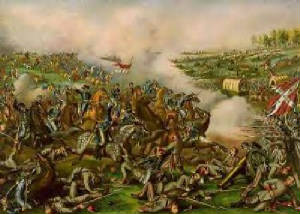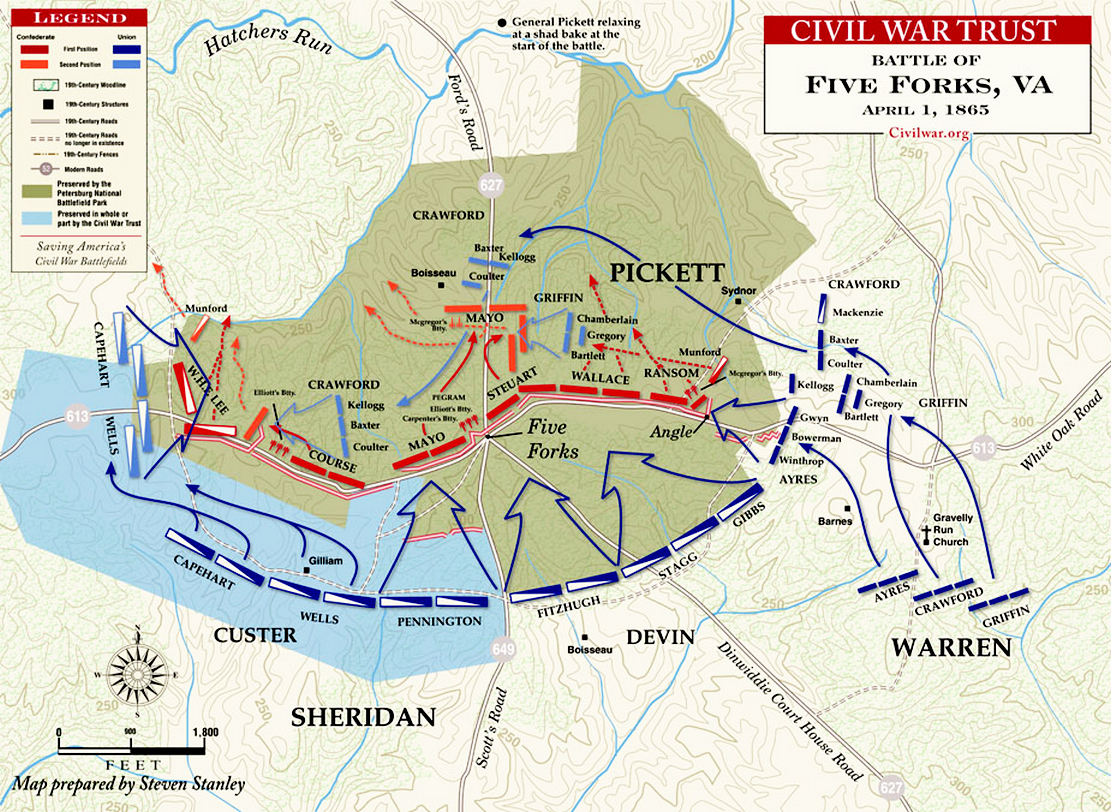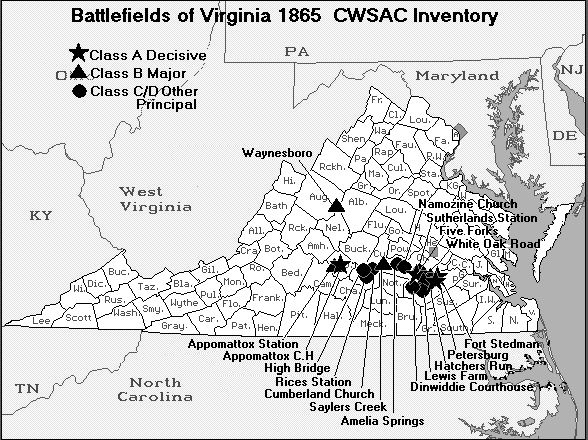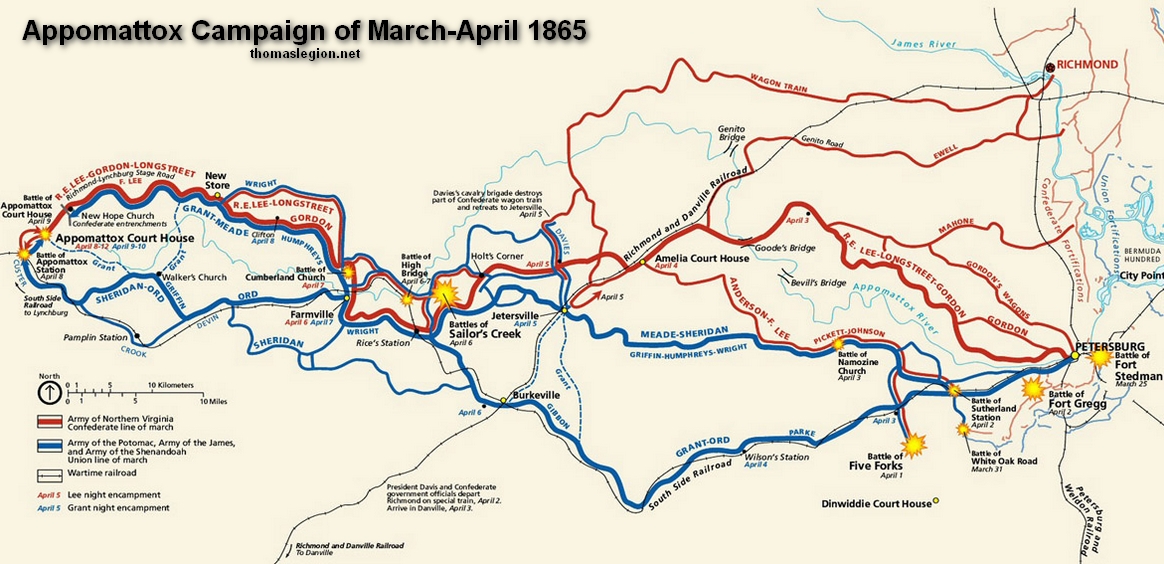|
Battle of Five Forks
Virginia Civil War History
Battle of Five Forks
Other Names: None
Location: Dinwiddie County
Campaign: Appomattox Campaign (March-April 1865)
Date(s): April 1, 1865
Principal Commanders: Maj. Gen. Philip Sheridan [US]; Maj. Gen. George Pickett [CS]
Forces Engaged: Corps
Estimated Casualties: 3,780 total (US 830; CS 2,950)
Result(s): Union victory
| Battle of Five Forks Virginia, April 1, 1865 |

|
| Painting by Kurz & Allison, Art Publishers (1866) |
Summary: Gen. Robert E. Lee ordered Pickett with his infantry division and Munford’s, W. H. F. Lee’s, and Rosser’s cavalry divisions to hold the vital crossroads of Five Forks at all hazard. On April 1, while
Sheridan’s cavalry pinned the Confederate force in position, the V Corps under Maj. Gen. G. K. Warren attacked and overwhelmed
the Confederate left flank, taking many prisoners. Sheridan personally directed the attack, which extended Lee’s Petersburg
lines, during the Siege of Petersburg, to the breaking point. Loss of Five Forks threatened Lee’s last
supply line, the South Side Railroad. The next morning, Lee informed Jefferson Davis that Petersburg and Richmond must be
evacuated. Union general Winthrop was killed; “Willie” Pegram, beloved Confederate artillery officer, was mortally
wounded. Dissatisfied with his performance at Five Forks, Sheridan relieved Warren of command of the V Corps.
Battle: In
the spring of 1865, Lt. Gen. Ulysses S. Grant had an opportunity to force Gen. Robert E. Lee's Army of Northern Virginia out
of its entrenchments at Petersburg by threatening its last supply line, the South Side Railroad. Grant ordered Maj. Gen.
Phil Sheridan and his cavalry to advance on the railroad by way of an important road junction known as Five Forks. Lee countered
this move by ordering Maj. Gen. George Pickett with his infantry division and cavalry under Thomas Munford, W.H.F. Lee, and
Thomas Rosser to hold the vital crossroads "at all hazards." After discovering the Confederate force, Sheridan secured infantry
support from Maj. Gen. Gouverneur K. Warren's Fifth Corps. After briefly stalling the Union advance on March 31, Pickett
withdrew his command to Five Forks and fortified his position. The next day, while Sheridan’s cavalry pinned the
Confederates in position, the Fifth Corps assaulted the Confederate left flank and rear, turning their position and taking
scores of prisoners. Pickett, who was attending a shad bake when the fighting began, was unaware that a battle was underway
until it was too late. Sheridan, meanwhile, personally directed the Union attack, often exposing himself to personal
danger while rallying the troops. Union Brig. Gen. Frederick Winthrop was killed; “Willie” Pegram, beloved Confederate
artillery officer, was mortally wounded. Though the Fifth Corps had performed well, Sheridan was nevertheless dissatisfied
Warren's performance during the battle and relieved him of command.
The resounding Union triumph heralded the end of the stalemate outside Petersburg
and set the stage for the breakthrough that followed the next day. On April 2, Lee informed Jefferson Davis that Petersburg
and Richmond would have to be evacuated. Lee surrendered to Grant only seven days later.
| Civil War Battle of Five Forks Map |

|
| Virginia Five Forks Battlefield Map |
| Battle of Five Forks, Virginia Map |

|
| Civil War Five Forks Battlefield Map |
Aftermath: The survivors of the Confederate infantry
brigades moved north through the woods and fields to ford Hatcher's Run and move over the W. Dabney road to a position near
the South Side Railroad. After some order was restored to the intermingled mass of survivors, Pickett moved the men in their
re-formed units toward Exeter Mills at the mouth of Whipponock Creek where he planned to ford the Appomattox River and return
to the Army of Northern Virginia.
Casualties: Historians offer a range of casualties. Some
are similar to Earl J. Hess's numbers of about 600 killed and wounded, 4,500 prisoners and thirteen flags and six guns lost
by the Confederates and 633 casualties for Warren's infantry and "probably...fewer" for Sheridan's cavalry. Noah Andre Trudeau
gives the same number of Union infantry casualties and a total of 830 Union casualties with 103 killed, 670 wounded, 57 missing.
Trudeau gives a "more modern accounting." Although earlier than Hess's account, Greene and several other historians state
that the Confederates lost about 605 killed and wounded and 2,400 taken prisoner. A. Wilson Greene later gives the same figures.
Chris Calkins also cites the lower estimate of Confederate prisoners. John S. Salmon gives Union casualties as 830 and Confederate
casualties as 605 plus 2,000 to 2,400 taken prisoner for a total of about 3,000 lost. This is nearly identical to the National
Park Service figures.
Analysis: The Battle of Five Forks was fought on April
1, 1865, southwest of Petersburg, Virginia, around the road junction of Five Forks, Dinwiddie County, Virginia, during the
end of the Richmond–Petersburg Campaign (sometimes called the Siege of Petersburg) and in the beginning stage of the
Appomattox Campaign near the conclusion of the American Civil War. A mobile task force of combined infantry, artillery and
cavalry from the Union Army commanded by Major General Philip Sheridan defeated a Confederate States Army combined task force
from the Army of Northern Virginia commanded by Major General George E. Pickett. The Union force inflicted over 1,000 casualties
on the Confederates and took between 2,400 and 4,000 prisoners while seizing Five Forks, the key to control of the South Side
Railroad (sometimes shown as Southside Railroad), a vital Confederate supply line to, and retreat line from, Petersburg.
The battle was immediately preceded by two battles on March 31, 1865. At
the Battle of White Oak Road, infantry of the Union Army's V Corps of the Army of the Potomac pushed back the main line of
Confederate defenses on the right flank of the Army of Northern Virginia southwest of Petersburg. The V Corps blocked two
important roads as well as taking a better position for an attack on the Confederate line. At the Battle of Dinwiddie Court
House, Sheridan's cavalry tactically lost a battle to Pickett's combined force but had fewer casualties and averted being
dispersed or forced to retreat from the area. At nightfall, Sheridan's troopers still held a defensive line 0.75 miles north
of Dinwiddie Court House.
On the night of the Battle of Dinwiddie Court House at about 10:00 p.m.,
V Corps infantry began to arrive near the battlefield to reinforce Sheridan's cavalry. This threat caused Pickett to retreat
about 6 miles to a modestly fortified line about 1.75 miles in length approximately half on either side of the junction of
White Oak Road, Scott Road and Dinwiddie Court House Road at Five Forks. Pickett's orders from General Robert E. Lee, commander
of the Army of Northern Virginia, were to defend Five Forks "at all hazards" (costs) because of its strategic importance as
the key to a supply line and evacuation route.
| Battle of Five Forks |

|
| Battle of Five Forks and the Appomattox Campaign |
At Five Forks at the beginning of the Union attack about 1:00 p.m., Sheridan
hit the front and right flank of the Confederate line with small arms fire from mostly dismounted cavalry troopers of Brigadier
General Thomas Devin's and Brigadier General (Brevet Major General) George Armstrong Custer's divisions from mostly wooded
positions just outside the Confederate breastworks. This fire pinned down the Confederates while the massed V Corps of infantry,
commanded by Major General Gouverneur K. Warren, after about two hours to organize, attacked the Confederate left flank.
With Sheridan fretting about the amount of remaining daylight and his cavalry
possibly running out of ammunition, the V Corps attacked about 4:15 p.m. Pickett and cavalry commander Major General Fitzhugh
Lee were having a late shad bake lunch about 1.5 miles north of the main Confederate line along White Oak Road in part because
they thought Sheridan was unlikely to be organized for an attack that late in the day. An acoustic shadow in the thick woods
and heavy, humid atmospheric conditions prevented them from hearing the opening stage of the battle. Pickett and Lee had not
told any of the next ranking officers of their absence and that those subordinates, in particular Major General W.H.F. "Rooney"
Lee, were temporarily in charge.
Because of bad information and lack of reconnaissance, two of the Union
divisions in the infantry attack did not hit the short Confederate left flank which was about 800 yards west of its supposed
location, but their movement by chance helped them to roll up the Confederate line by coming at it from the end and rear.
The first division in the attack under Brigadier General Romeyn B. Ayres alone overran the short right angled line on the
left side of the Confederate main line. Sheridan's personal leadership
helped encourage and focus the men. Brigadier General Charles Griffin's division recovered from overshooting the Confederate
left and helped roll up additional improvised Confederate defense lines. Brigadier General (Brevet Major General) Samuel Crawford's
division swept across north of the main battle but then closed off Ford's Road, swept down to Five Forks and helped disperse
the last line of Confederate infantry resistance. The Union cavalry was somewhat less successful as much of the Confederate
cavalry escaped while much of the Confederate infantry became casualties or prisoners. Due to more apparent than real lack
of speed, enthusiasm and leadership, as well as some past grudges and a personality conflict, Sheridan unfairly relieved Warren
of command of V Corps when the successful battle concluded. The Union Army held Five Forks and the road to the South Side
Railroad at the end of the battle. Grant ordered an attack all along the line at Petersburg for the next day.
Pickett's loss at Five Forks along with the Union breakthrough of the defenses
of Petersburg the next day at the Third Battle of Petersburg forced General Lee to abandon his entrenchments and fortifications
around Petersburg and the Confederate capital of Richmond, Virginia and to begin the retreat that led to the surrender of
the Army of Northern Virginia at Appomattox Court House, Virginia on April 9, 1865.
(Sources and related reading below.)
Sources: National Park Service; Civil War Trust, civilwar.org;
Beringer, Richard E., Herman Hattaway, Archer Jones, and William N. Still, Jr. Why the South Lost the Civil War. Athens: University
of Georgia Press, 1986. ISBN 978-0-8203-0815-9; Bearss, Edwin C., with Bryce A. Suderow. The Petersburg Campaign. Vol. 2,
The Western Front Battles, September 1864 – April 1865. El Dorado Hills, CA: Savas Beatie, 2014. ISBN 978-1-61121-104-7;
Bonekemper, Edward H., III. A Victor, Not a Butcher: Ulysses S. Grant's Overlooked Military Genius. Washington, DC: Regnery,
2004. ISBN 978-0-89526-062-8;Calkins, Chris. The Appomattox Campaign, March 29 – April 9, 1865. Conshohocken, PA: Combined
Books, 1997. ISBN 978-0-938-28954-8; Davis, Burke. To Appomattox: Nine April Days, 1865. New York: Eastern Acorn Press reprint,
1981. ISBN 978-0-915992-17-1. First published New York: Rinehart, 1959; Davis, William C. An Honorable Defeat: The Last Days
of the Confederate Government. New York: Harcourt, Inc., 2001. ISBN 978-0-15-100564-2; Eicher, David J. The Longest Night:
A Military History of the Civil War. New York: Simon & Schuster, 2001. ISBN 978-0-684-84944-7; Freeman, Douglas S. Lee's
Lieutenants: A Study in Command. Gettysburg to Appomattox. Vol. 3 of 3 vols. New York: Scribner, 1944. ISBN 978-0-684-10177-4;
Greene, A. Wilson. The Final Battles of the Petersburg Campaign: Breaking the Backbone of the Rebellion. Knoxville: University
of Tennessee Press, 2008. ISBN 978-1-57233-610-0; Hattaway, Herman, and Archer Jones. How the North Won: A Military History
of the Civil War. Urbana: University of Illinois Press, 1983. ISBN 978-0-252-00918-1; Hess, Earl J. In the Trenches at Petersburg:
Field Fortifications & Confederate Defeat. Chapel Hill: University of North Carolina Press, 2009. ISBN 978-0-8078-3282-0;
Horn, John. The Petersburg Campaign: June 1864-April 1865. Conshohocken, PA: Combined Publishing, 1999. ISBN 978-0-938289-28-9;
Humphreys, Andrew A., The Virginia Campaign of 1864 and 1865: The Army of the Potomac and the Army of the James. New York:
Charles Scribners' Sons, 1883. OCLC 38203003; Keegan, John, The American Civil War: A Military History. New York: Alfred A.
Knopf, 2009. ISBN 978-0-307-26343-8; Kennedy, Frances H., ed., The Civil War Battlefield Guide, 2nd ed., Houghton Mifflin
Co., 1998, ISBN 978-0-395-74012-5; Longacre, Edward G. The Cavalry at Appomattox: A Tactical Study of Mounted Operations During
the Civil War's Climactic Campaign, March 27 – April 9, 1865. Mechanicsburg, PA: Stackpole Books, 2003. ISBN 978-0-8117-0051-1;
Longacre, Edward G. Lee's Cavalrymen: A History of the Mounted Forces of the Army of Northern Virginia. Mechanicsburg, PA:
Stackpole Books, 2002. ISBN 978-0-8117-0898-2; Marvel, William. Lee's Last Retreat: The Flight to Appomattox. Chapel Hill:
University of North Carolina Press, 2002. ISBN 978-0-8078-5703-8; Salmon, John S., The Official Virginia Civil War Battlefield
Guide, Stackpole Books, 2001, ISBN 978-0-8117-2868-3; Simpson, Brooks D. The Civil War in the East: Struggle, Stalemate, and
Victory. Santa Barbara, CA: Praeger, 2011. ISBN 978-0-275-99161-6; Trudeau, Noah Andre. The Last Citadel: Petersburg, Virginia,
June 1864–April 1865. Baton Rouge: Louisiana State University Press, 1991. ISBN 978-0-8071-1861-0; Trudeau, Noah Andre.
"Out of the Storm: The End of the Civil War, April–June 1865. Boston, New York: Little, Brown and Company, 1994. ISBN
978-0-316-85328-6; Trulock, Alice Rains. In the Hands of Providence: Joshua L. Chamberlain and the American Civil War. Chapel
Hill: University of North Carolina Press, 1992. ISBN 978-0-8078-2020-9; Weigley, Russell F. A Great Civil War: A Military
and Political History, 1861–1865. Bloomington and Indianapolis: Indiana University Press, 2000. ISBN 978-0-253-33738-2.
|

